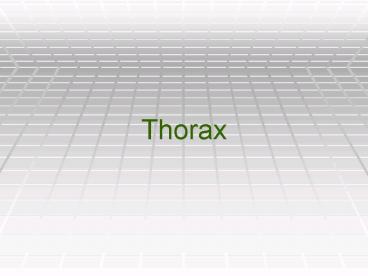Thorax - PowerPoint PPT Presentation
1 / 44
Title:
Thorax
Description:
Ribs 1 through 7 are called 'true ribs'. Ribs 8 through 12 are ... Crepitus. Muscle strains. Occur due to over use or over stretching. Myocardial Infarction ' ... – PowerPoint PPT presentation
Number of Views:72
Avg rating:3.0/5.0
Title: Thorax
1
Thorax
2
Thorax
- Anatomy
- Injuries
- Evaluation
- Rehabilitation
3
Anatomy
- Bones
- Cartilage
- Muscles
- Organs
4
Bones
- Ribs
- Sternum
- Xiphoid process
5
Ribs
- Ribs 1 through 7 are called true ribs.
- Ribs 8 through 12 are called false ribs.
- Ribs 11 and 12 are also called floating ribs.
6
Sternum
- Located in the center of the chest.
- Is the site where the bones attach anteriorly.
- Protects the heart
7
Xiphoid process
- Located at inferior aspect of the sternum
8
Cartilage
- Ribs 1-7 attach to sternum
- Ribs 8-10 attach to cartilage of 1-7
9
Muscles
- Pectoralis major
- Latissimus Dorsi
- Trapezius
10
Pectoralis Major
- Largest muscle of chest
- Anterior aspect of the thorax
11
Latissimus Dorsi
- Largest muscle of the back
- Located on the posterior aspect of the thorax
12
Trapezius
- Muscle of the posterior neck and upper back.
13
(No Transcript)
14
Organs
- Heart
- Lungs
- Diaphragm
15
Heart
- Size of a fist
- Responsible for pumping blood to all parts of
body
16
Lungs
- Site of oxygen/carbon dioxide exchange
- Site of O2 CO2 exchange
17
Diaphragm
- Separates the thorax and the abdominal cavity.
- Contraction pulls down to assist with inhalation,
and moves upward to push air out of the lungs.
18
Diaphragm
19
Injuries to Thorax
- Strains
- Contusions
- Fractures
- Heart Attack
- Pneumothorax
- Hemothorax
- Asthma
20
Rib contusion
- Signs and Symptoms
- point tenderness
- possible ecchymosis
- pain with excessive movement
- Pain with inspiration/expiration
21
Rib fractures
- Tremendous forces are necessary
- can cause damage to the liver, spleen, kidney,
or lung injuries
22
Rib fractures
23
Rib fractures
24
Rib fractures
- Signs and symptoms
- Pain at fracture site aggravated by coughing,
breathing, movement, and compression tests. - Dyspnea (shortness of breath)
- Localized tenderness
- Crepitus
25
Muscle strains
- Occur due to over use or over stretching.
26
Myocardial Infarction
- Heart attack
- occurs when the blood supply to a part of the
heart is interrupted. - The resulting oxygen shortage causes damage and
potential death of heart tissue.
27
Myocardial Infarction
- Causes
- Usually due to blockage of one or many of the
coronary arteries supplying blood to the heart
(HEART DISEASE) - MI can also be caused by an electrical shock and
certain drugs
28
Myocardial Infarction
- Signs and Symptoms
- Persistent chest pain or pressure
- Breathing difficulty noisier, shorter, faster
than normal. - Irregular pulse rate
- Cyanosis (bluish color of skin)
- Moist face or profuse sweating
- Radiation or pain in the left side (neck,
shoulder, arm)
29
Myocardial Infarction
- Treatment
- If you suspect an MI, Call 9-1-1
- Keep person calm
- Monitor ABCs
- Monitor vital signs
30
Pneumothorax
- Air accumulation in the pleural space. This can
cause the lung to collapse. - A pneumothorax can be caused by a blunt force or
sharp trauma to the anterior chest wall.
31
Pneumothorax
32
Pneumothorax
- SIGNS/SYMPTOMS
- sudden sharp chest pain, especially made worse by
a deep breath or a cough - Shortness of breath
- chest tightness
- fatigue
- Rapid heart rate
- cyanosis
- hypotension (low blood pressure)
33
Hemothorax
- similar to a pneumothorax but blood, instead of
air, enters the pleural cavity.
34
Hemothorax
35
Hemothorax
- If this injury is suspected, call 9-1-1
- Treat person for shock
- Monitor vitals
36
Asthma
- Inflammatory respiratory condition characterized
by bronchospasm and shortness of breath. - Usually treated with medication (administered
through an inhaler)
37
Asthma
38
Evaluation
- History
- Observation
- Palpation
- Stress Tests
39
History
- Mechanism of injury
- Onset of symptoms
- Location of injury
40
History
- Type and location of any abnormal sensations
- Progression of signs and symptoms
- Activities that make the symptoms better or worse
- Nausea
- Weakness
- Dyspnea (shortness of breath)
41
Observation
- Respiratory rate
- Moistness and color of the skin
- Pulse rate
- Tachycardia (rapid pulse)
- Bradycardia (slow pulse)
42
Observation
- Blood pressure
- Movement
- Pulse
- Respiration
- Skin Color
- State of consciousness
- Temperature
43
Palpation
- Ribs- Side to side and front to back
- Sternum
- Start away from injury site and work towards it.
44
Stress tests
- Active Range of Motion































